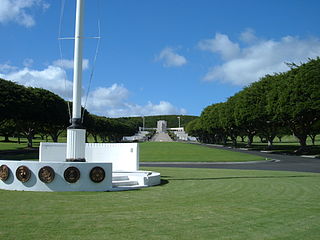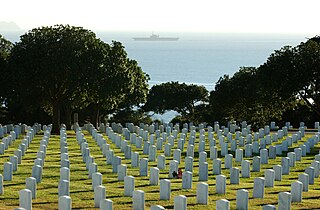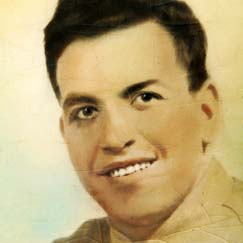
William Harvey Carney was an American soldier during the American Civil War. Born enslaved, he was awarded the Medal of Honor in 1900 for his gallantry in saving the regimental colors during the Battle of Fort Wagner in 1863. The action for which he received the Medal of Honor preceded that of any other African American Medal of Honor recipient; however, his medal was actually one of the last to be awarded for Civil War service. Some African Americans received the Medal of Honor as early as April 1865.

The National Memorial Cemetery of the Pacific is a national cemetery located at Punchbowl Crater in Honolulu, Hawaii. It serves as a memorial to honor those men and women who served in the United States Armed Forces, and those who have been killed in doing so. It is administered by the National Cemetery Administration of the United States Department of Veterans Affairs and is listed on the National Register of Historic Places. Millions of visitors visit the cemetery each year, and it is one of the most popular tourist attractions in Hawaii.

Fort Rosecrans National Cemetery is a federal military cemetery in San Diego, California. It is located on the grounds of the former Army coastal artillery station Fort Rosecrans and is administered by the United States Department of Veterans Affairs. Fort Rosecrans is named after William Starke Rosecrans, a Union general in the American Civil War.

William Hart Pitsenbarger was a United States Air Force Pararescueman who flew on almost 300 rescue missions during the Vietnam War to aid downed soldiers and pilots.

Riverside National Cemetery (RNC) is a cemetery located in Riverside, California, dedicated to the interment of United States military personnel. The cemetery covers 921 acres (373 ha). It has been the most active cemetery in the system since 2000, based on the number of interments.

Private First Class James Anderson Jr. was a United States Marine who posthumously received the Medal of Honor for heroism while serving in Vietnam in February 1967. When his Medal of Honor was awarded on August 21, 1968, he became the first African American U.S. Marine recipient of the Medal of Honor while serving in Vietnam.

Walter Keith Singleton was a United States Marine Corps sergeant who was awarded the Medal of Honor posthumously by President Lyndon B. Johnson, for his actions above and beyond the call of duty in Vietnam on March 24, 1967, during the Vietnam War.

Milton Lee Olive III was a United States Army soldier and a recipient of America's highest military decoration — the Medal of Honor — for his heroic action in the Vietnam War, when, at the age of 18, Olive sacrificed his life to save others by falling on a grenade. In doing so, he became the first African-American recipient of the Medal of Honor from the Vietnam War.

Staff Sergeant Ysmael Reyes Villegas, was a United States Army soldier who was posthumously awarded the Medal of Honor, the United States' highest military decoration, for heroism during World War II at the Battle of Luzon.
William Henry Barnes was a Union Army soldier during the American Civil War and a recipient of the Medal of Honor, America's highest military decoration. He was African American.

Sergeant First Class Elmelindo Rodrigues Smith was a United States Army soldier, of Hispanic-Asian descent, who was posthumously awarded the Medal of Honor for his actions in the Vietnam War. Despite being severely wounded, Smith inspired his men to beat back an enemy assault.

Nicky Daniel Bacon was a United States Army first sergeant from the Americal Division who served during the Vietnam War. For his actions in combat in Tam Ky, Vietnam, Bacon was awarded America's highest military decoration, the Medal of Honor.

Bruce Alan Grandstaff was a United States Army soldier and a recipient of the United States military's highest decoration—the Medal of Honor—for his actions in the Vietnam War.

Audie Murphy was one of the most decorated United States Army combat soldiers of World War II, serving from 1942 to 1945. He received every American combat award for valor available at the time of his service, including the Medal of Honor. He also received recognitions from France and Belgium. With his 1945 military discharge at the end of the war, Murphy became an advocate of treatment for post-traumatic stress disorder in veterans. The Audie L. Murphy Memorial VA Hospital in San Antonio and the Sergeant Audie Murphy Clubs (SAMC) on military bases honor his contributions. He joined the Texas National Guard in 1950, transferring to reserve status in 1956 and remaining in the Guard until 1969. He also had a civilian career as a film actor and songwriter. Recognitions he received both during his lifetime and posthumously are listed below.
Edgar A. Bras was a United States soldier who fought with the 8th Iowa Volunteer Infantry Regiment during the American Civil War. He received his nation's highest award for valor, the U.S. Medal of Honor, for the bravery he displayed during the Battle of Spanish Fort in Alabama on April 8, 1865. That award was conferred on June 8, 1865.

Staff Sergeant Salvador J. Lara was a U.S. Army veteran of World War II and recipient of the Medal of Honor. He was of Mexican-American descent.















